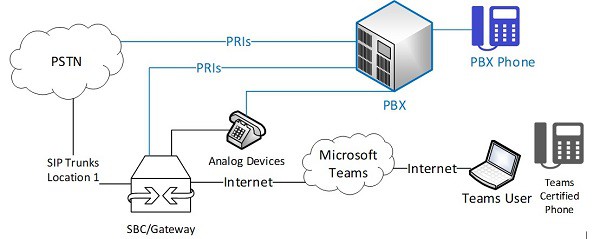Melissa Swartz | January 27, 2021
If you’re considering the use of Microsoft Teams to provide voice calling, you probably know you have multiple options available to you: At the highest level, you can choose between Microsoft Calling and Direct Routing. With Microsoft Calling, you buy your PBX licenses and PSTN trunks from Microsoft, either through domestic calling only or domestic and international calling plans in the U.S. Rather than Calling, most of my clients are choosing Direct Routing, because it offers the flexibility to select a carrier rather than using Microsoft PSTN trunks. Before you make a similar choice, be sure you understand the complexity of options beneath the Direct Routing umbrella.
Direct Routing Options
The first Direct Routing option is what I call “DIY Direct Routing,” or “bring your own dial tone.” With this option, your organization is responsible for obtaining and managing the connections to the PSTN. Assuming that you aren’t planning a flash cut of all users and locations to the new services, you’ll have a transitional environment where your legacy PBX and services must work alongside the Teams voice calling setup.
This transitional environment looks like this:

- You’re under contract for PRI or SIP services and would have to pay termination penalties if you moved your calling off these services.
- You want to migrate a few users to Teams, but aren’t ready to take on a full-scale migration yet.
- You want to have a gradual, controlled migration of users. If you port all of your numbers to your new PSTN connection (the SIP trunks in the above diagram), you can configure the session border controller (SBC) to route calls either to the legacy PBX or to Teams for each individual DID number.
- Your users will still be able to dial each other during the transition, as long as the appropriate configuration is done as users migrate to the new solution.
- You have special needs for redundancy and uptime and don’t trust the reliability of dial tone over the Internet. This option would allow you to build in the reliability that you require by adding SIP trunks at another site, for example.
Read more about navigating SIP Trunking.

- You still have on-premises equipment to manage and update with the SBC/gateway hardware.
- You still have to manage your carrier (for the SIP trunks in the diagram above) and the associated contracts.
- You still must manage and pay a separate phone bill to the carrier.
Dial tone done for you

- If your organization has an overall strategy and plan to move to the cloud, this is a much better fit than a DIY approach. You’ll have no SBC hardware to deal with or carrier contract and bills to manage.
- You have options beyond the Teams feature set for advanced call routing and handling.
- If you have many phones that aren’t associated with specific users, most cloud providers can save you money on devices and licensing, when compared to putting them into Teams.
- The cloud provider is responsible for obtaining and managing the services and carriers needed to meet their uptime commitments.
- Some cloud providers offer backup solutions should a failure occur in the Microsoft environment.
- Some cloud providers offer portals that give you the ability to route your numbers elsewhere in the case of an outage.

- If you have analog devices to support, you’re not completely free of needing to support on-premises hardware. This setup will require gateways or adapters.
- Not all cloud providers offer a backup option or portal with full routing control.
- Not all cloud providers support Microsoft’s Dynamic 911 capability, so you may need to associate users to a specific site for 911 calls, even if they’re not at that location when they make a 911 call.
- You really have to look at the costs. Cloud providers that I’ve worked with all charge a monthly fee per user. But here are some considerations:
- You may need to take into account additional charges for calling plans, international calls, toll-free calls, etc.
- Does the base price per user include features available in Teams? You could be paying twice for these capabilities.
- Do you have to pay a per-user charge for the connection to the Teams environment?
- Watch out for high hidden costs for DID numbers, 911 access, and other fees and surcharges. These can increase a bill by 25% or more. Ask to see an actual bill to see what additional charges you’ll incur.
Read more about what you could be getting in a cloud solution.

